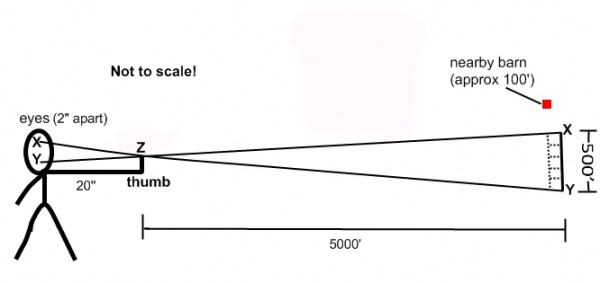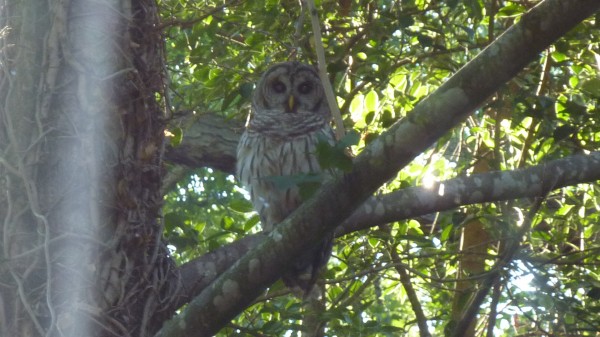
Estimating distance is a crucial skill in various scenarios such as daily life, hiking, and survival situations. It helps you maintain your sense of direction, calculate distance and height, and estimate travel time while hiking relative to your pace.
Did you know you can estimate distance using only your finger? Estimating distance using only your finger is based on this known fact about human anatomy: Your arm is about ten times longer than the distance between your eyes. Here’s how you can use this information to estimate distance:
Imagine you’re standing on a hill, and you want to estimate the approximate distance to where the trail disappears into a thicket of blueberry bushes. You notice a red barn nearby, which you estimate is about 100 feet wide.
To calculate the distance, hold your right arm out directly in front of you with your elbow straight and your thumb upright. Align your thumb with one eye closed to cover (or align) the distant object, marked as X in the drawing.

To calculate the distance:
- Hold your right arm out directly in front of you, elbow straight, thumb upright.
- Align your thumb with one eye closed to cover the distant object. The point is marked X in the drawing.
- Without moving your head, arm, or thumb, switch eyes so that the other one is open, and the closed one is now open. Observe where the object appears now with the other open eye. Your thumb should appear to have shifted to another point, no longer in front of the object. This new point is marked Y in the drawing.
- Estimate the displacement XY by relating it to the estimated size of something you are familiar with, such as the height of a tree, building width, length of a car, power line poles, or the distance between nearby objects. In this scenario, the distant barn is estimated to be 100 feet wide. It appears that 5 barn widths could fit this displacement or 500 feet. Now multiply that figure by 10 (the ratio of the length of your arm to the distance between your eyes), and you get the distance between you and the thicket of blueberry bushes – 5000 feet away (approximately 1 mile).
Here’s why it works: when you hold out your thumb and view it with one eye open, then switch the view to the other eye, your finger seems to shift relative to the object’s background. This phenomenon is known as parallax. The parallax of a distant object is the angle between its directions of view from the two ends of a baseline.
To accurately measure the distance to a faraway object, you must view it from at least two points.The baseline is the line connecting those points. You can then use simple trigonometry to estimate the distance. In the illustration, notice the thumb forms the tip of two identical proportional triangles. The base of the first triangle is the distance between the eyes (about 1/10 of the distance between the thumb and the eyes). The same ratio holds for the second triangle, between the thumb and two distant points it covers when viewed from either eye.
Even though humans vary in height, our anatomical proportions are similar. The angle of the line between our eyes (XY) to the thumb is about 6 degrees, a ratio of 1:10. The smaller triangle XYZ has the same portion as the larger triangle XYZ; If the distance YZ to thumb is 10 times the distance XY between the eyes, the distance XZ to the far object is 10 times distance XY. In other words,
The distance from your eyes to your thumb is about 10 times the distance between your eyes. Thus, the distance of a faraway object is also about 10 times the width your thumb seems to move from that object.

Why parallax exists
Like other animals, humans have two eyes positioned apart to present different views simultaneously. This feature allows the eye to gain depth perception and estimate distances. Not all animals function in this manner. Some animals use motion parallax, moving their head to gain different viewpoints. For example, most birds (whose eyes do not have overlapping fields of view and thus cannot see depth) have eyes on the sides of their heads, making their vision mostly monocular. Pigeons use motion parallax by bobbing their heads up and down to see depth. Owls, on the other hand, have binocular vision. Their eyes are spaced apart, similar to humans. The barred owl pictured below is a frequent visitor in our backyard.

This simple eye-to-finger rule is handy for estimating the distance to a faraway landmark, such as a tree, water tower, or trailhead parking lot. With some practice, you can perform a quick thumb estimate in seconds. Perform the test a few times at home with known distances. How accurate is this estimate for you?
Related Posts:
References
8 thoughts on “How Far? How to Estimate Distance with your Thumb”
Very well written with clear text and images. Thanks
Awesome
what if you have no idea how wide the barn is?
That’s why you can’t always apply that method, but with some common sense it’ll give you good results.
I’m blind in 1 eye….are there other methods for estimating distance
Yeah, milliradians with your fingers.
Thanks for sharing valuable information with us.
I too appreciate your high mindedness in sharing this potentially life-saving information.
It is said that knowledge is power and certainly, I agree with this notion.
Rather than empowering their fellow man by passing along acquired skills, it is sadly most popularly practiced by limited thinking people to instead hoard information they deem has any value.
As a species, we cannot truly evolve until we unite together to better ourselves as one!